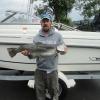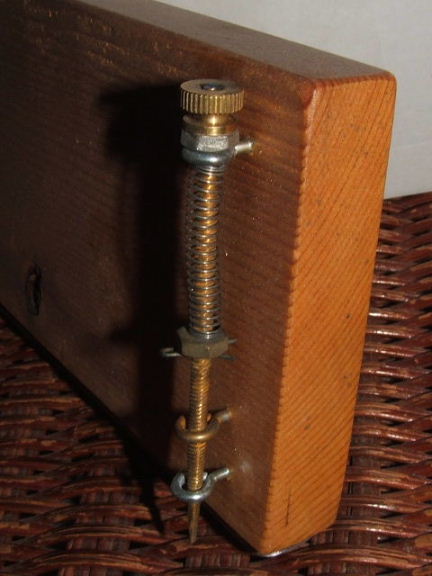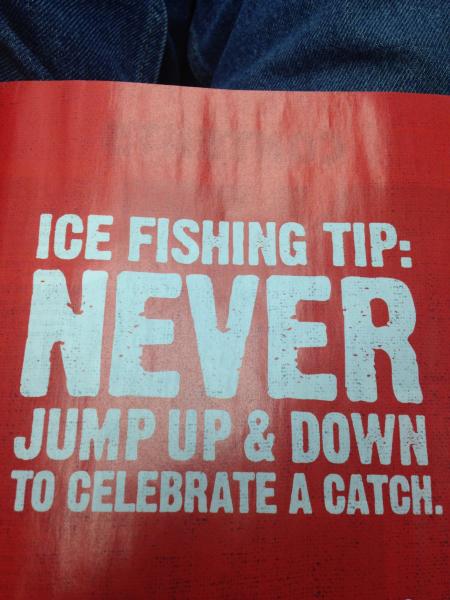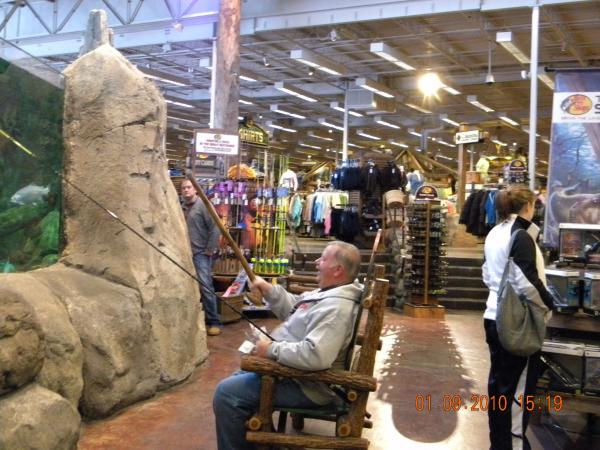-
Posts
13,865 -
Joined
-
Last visited
Everything posted by Sk8man
-
I've carried one with me for years but have never actually had to use it even with big northerns or lakers on light line. Usually you can just slide them out of the hole carefully if you let them get tired first (assuming the jig is in the side of their mouth and not swallowed). If using live bait I usually use a light wire leader because pike usually swallow the bait. Get their head started out of the hole and turned to the side and stick a finger carefully in the bottom of the gill (avoiding the mouth itself) and quickly "slide" them over the edge of the hole. This is admittedly more difficult if you have built up mounds of snow around your hole though (to keep the wind out).
-
You are very right EsoxAC3. At the very least some sort of life jacket or floatable device should be carried with people out there. It is interesting that people are required to wear life jackets from Nov-April in boats but not out on the ice. I must also say however I'm not a big fan of governmental requirements/intervention in our lives but with some things you can't always depend on people to just use good common sense and this appears to be one of them. People (including me) become complacent about that stuff and they think it is only "the other" guy that it happens to ....until IT IS YOU and that is a rude awakening. The most surprising thing to me was that after many many years on the ice (starting at about 8 yrs old) that I thought there would be some warning (cracking sounds etc.) but it was just instantaneous and like dropping into a "slush hole". Worst of all is the realization that your legs and arms start going numb in seconds not minutes and as soon as you are out of the water hypothermia starts setting in and even walking is difficult. I had on a snowmobile suit and heavy boots at the time and it felt like it weighed a thousand pounds. My left side was still bruised from the edge of the ice a month afterward. If it had been even a foot or two deeper I would have been "history". 2004....not one of my best years
-
John makes some very good points. The main reason I use the mono backing is to avoid slippage as well as help decrease direct pressure on the spool from the wire tightening. This was suggested to me by the folks at Tuna Tom's reel repair a few years ago.
-
I've been through myself twice and one of the times it was in 5 1/2 ft of water and I am 6 ft tall and I was all alone on the lake at 6:45 AM (that is the reason for my, comment in number 1). My next action after that time was to buy suits that float for myself and my son (Arctic Armor) and we both got to try them out in 3 ft of water coming back in near dark at Honeoye a couple years ago (late season)
-
-
Try contacting Chad Lapa by using the "Contact us" at the bottom of the page
-
I guess everyone has their favorite set up but you may wish to consider Bloodrun (Amazon?) 30 lb 7 strand wire in the brown/camo color and the 30 lb Big Game mono for the backing. Don't use braid straight on the spool spindle of the reels. Use good quality (e.g. Seaguar red or blue label) fluorocarbon leader (length up to you I usually use about 8-20 ft). I usually use 20 lb test for running spinneys and flashers. There is also 19 strand wire from Torpedo that is easier on the tips and eyes. If you can't find Bloodrun wire Accustrand and Mailn are good and Mason works too. Make sure you use a twilli tip (e..g. fish307.com) or a rod with a roller tip for the wire ...it will cut into most conventional rod guides and/or tips. Some guys worry about having enough backing but make sure you leave plenty of room to get all your wire on. In my view the backing is primarily to keep the reel spool intact from the pressure of the wire. I have never even come close to being spooled (even with big kings) so I don't worry about the backing issue. If you have your drag set right and know how to "work" your boat against fish it shouldn't ever be an issue with the 30 lb wire in fresh water at least.
-
-
Guess I'd rather take my chances explaining to a judge than being greeted by St Peter
-
Or for keeping a magnum under your jacket
-
I'm anxiously awaiting another season on the ice and thought that it might be an appropriate time to see if others here are willing to share any tips or helpful information they have discovered over the years to help out folks who might be interested but inexperienced to speed up the learning curve a bit. I'm not talking about divulging your life long closely held spots or derby tactics or anything just some helpful hints: I'll start it off with these as examples: (they can be specific fishing tactics, safety tips, things you have discovered to be comfortable etc.) 1. Wait until there is good hard ice at least 3 inches thick before going out there and don't go alone. Check thickness along the way at intervals. Remember: the most dangerous ice is not necessarily the hard clear stuff that may spook you or is slippery it is snow covered ice where you can't detect what is beneath you (gas pockets, faults, thin ice spots or other defects. 2. Take a "spud" or "ice chisel" with you besides having your auger and use it to "test" the ice. 3. Tape up some soft material (e.g. short section of swimming noodle) to the mid part of the rope of your sled for hand comfort 4. Carry a flashlight of some sort (inexpensive LED headlamp) for coming back in in the dark and it can double for "charging up" glow jigs as well. If using the headlamp get one that uses triple A batteries rather than the often hard to find disc type. 5. Carry "ice picks" on a cord and easily accessible in case of emergency (I also usually carry a boat seat cushion with a rope attached as well in my sled) 6. A propane or gas heater can be a welcome addition to your day as well as good warm gloves and heavily insulated boots 7. Dress in layers (plenty of them) to stay comfortable. You can always shed things if you get too warm and you don't want to start sweating because you'll be chilled. 8. Don't bring any more items than you'll actually need (I'm VERY guilty of this) because the trip out and back will seem MUCH longer as a result 9. Buy a good auger (whether power, hand, or battery powered drill type) and keep the blades sharp. Keep the cover over the blades when not in use because it keeps them sharp as well as protecting you from disaster. 10. Drill a bunch of holes when you first get to your spot whiie you are "fresh" and also so that you'll allow things to calm down (noise etc.) and any fish that were "spooked" may return to the area. 11. If you are "prospecting" or don't have a depth finder) drill some holes in an "X'" shape with holes spread out 20-30 ft from each other starting from shoreward working outward. That will allow you to determine a depth "range", give an idea of the "slope" of things as well as possible bottom characteristics (e.g. mud, weeds, gravel) and by jigging in the holes you may be able to see the direction of any fish action for further consideration. 12. Assess wind direction when you are at your spot and face your shelter (if you use one or your back if you just sit on a bucket) away from the oncoming wind whenever possible 13. Buy (inexpensive) hand warmers to put in your mits or gloves. They last for many hours 14. For your main jigging hole to help keep it from freezing over pour a little coffee or other hot liquid in it. 15 To keep bait alive and unfrozen I keep mine in a small Little Oscar cooler that has a lid that locks down. It is relatively small but holds a lot of fathead minnows and it is insulated so it can take the real cold 16. Bring a tape measure with you for game fish in case you get lucky. 17. If fishing from an ice shelter (Clam Frabill, Eskimo etc.) anchor it and help keep the wind out by placing snow around the bottom of it (skirt) "sealing it off" 18. White LED battery powered Xmas lights strung on the supports or taped to the inside work well for lighting when needed. 19. Don't try to change jigs right over your hole or open a box of hundreds of jigs balancing it on your knee in the snow.....and don't ask how I know this 20. Consider buying a hand held depth finder (one of my handiest purchases over the years) which saves a lot of time especially in unfamiliar places. It will allow you in clear (bubble free) ice to get depth readings as you go along and to spot bottom drop offs/contours. See pic. 21. Early ice and late ice are often the most dangerous times out there. Pay particular attention to areas where "bubblers" are used near docks where the ice may be undercut many yards away from the action (speaking from personal experience).
-

Sold / Closed great guy to deal with
Sk8man replied to BarringtonTrapper's topic in Classifieds - Buy, Sell, Trade or Rent
Except when their website security is compromised...I no longer trust them or deal after a major screwup with an account I had. It works OK until they are hacked again -
Geez, kinda depressing....what will we use for an excuse next year for not catching salmon? Hey tell me the guy in the next article entitled "Early Surfin on Oneida Lake" doesn't look like a dead ringer for Todd on the Goldrush show on the Discovery channel
-
Just part of the up and down cycle....have seen it since 1975 and it has been worse when the bait was down as well ......the numbers of young fish should be a good omen for the near future especially with the bait population looking healthy as long as there aren't any environmental or weather disasters.
-

Now that the kings have run...opinions, please.
Sk8man replied to Gator's topic in Open Lake Discussion
Chas I think that the distribution of the bait may have been screwed up because many folks including me saw hoards of bait out there this season and a lot of it without fish appearing to be nearby. -

Now that the kings have run...opinions, please.
Sk8man replied to Gator's topic in Open Lake Discussion
Keith's question is a great one. I think no matter how you slice it the accurate answer will be complicated and complex and should take into consideration the Canadian side of the pond also to get a good handle on it. The data numbers from the Salmon river and egg collection effort would be important information for the equation too. It did seem to be a rather unusual year from the standpoint of the apparent migration pattern and the expected numbers at various points along the way but many variables affect that anyway (bait locations, currents, water temps, weather/wind. If there was a true shortage I should think that the Salmon River results should be a pretty good general index of things. It seemed that there were a lot of smaller fish this year trolling in the lake at least with a weak display of fish in the high 20's through 30 lb range from the reports here anyway. I can't help but think something affected the upper year class somewhere along the line. -
It is a very useful tool once the thermocline sets up and through the summer into early Fall but it is only one tool in the box. Sometimes fish operate outside their temp ranges and folks can get stuck in gear fishing desired temp ranges and over reliance on temp meters. It is useful but not necessary in my view. I think learning to use your depth finder competently combined with knowledge gained from repeated experience and learning to watch the angle of your lines and your boat speed offer much better data than any ONE item of electronics. By the way look carefully if you decide to buy a Fish Hawk because you can get them cheaper than $700. I will say that the company is second to none and Trevor Sumption stands behind his products....great folks with a great product.
-
-

Furuno vs raymarine vs garmin opinions please
Sk8man replied to flywasher's topic in Questions About Trout & Salmon Trolling?
The only difference in the oceans would be the transducer....there you'd want the 50khz for deep water and most of those depth finders have a salt water setting in the menu -
Four strokes are the way to go.....great on gas and much quieter than two strokes....I can barely hear someone talking above my 9.9 2 stroke. If money isn't tight I'd say get a 9.8 or 9.9 or even a 15 if you can do it as they offer a little "insurance" if you go dead in the water with your main motor and although a 9.8 is great for trolling and semi rough water the 15 could get you in to shore faster in rough water on Lake O. When that stuff happens you always wish you had a bigger motor no matter what you have The 4 strokes are much more economical.
-
With both my Church 44's and Walleye boards I set the line as far back in the release as possible and I have the jaws tightened as much as possible (have to be careful not to tighten too much though or they could break). They are usually run on braid or 30 lb mono and I've only had it release once with a fish and huge gob of grass combined.
-

Furuno vs raymarine vs garmin opinions please
Sk8man replied to flywasher's topic in Questions About Trout & Salmon Trolling?
Most of the "big boys" on the ocean are running Furuno's and it is for a reason...they are very reliable. Although I have had Lowrance's lately and I have had other brands as well over the years since 1975 including a graph recorder and flasher that were kits where every diode had to be soldered onto the board and the entire units hand assembled (Heath Kits). Thankfully my dad was a radio and TV repair guy If $$$ isn't the main factor Furuno is the way to go. I've seen Admiral Byrd's units in action firsthand many times too over the years and in my opinion they are superior units.




